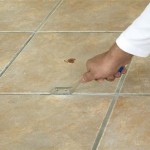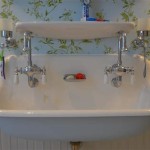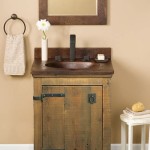How to Build Under Bathroom Sink Storage
Maximizing bathroom storage is essential for creating a functional and aesthetically pleasing space. The area under the bathroom sink often remains underutilized, but with a little creativity, you can transform this space into a storage haven for your bathroom essentials. This article will guide you through the process of building under-sink storage, highlighting key steps and considerations to achieve a well-organized bathroom.
1. Planning and Measuring
Before embarking on the construction process, meticulous planning is crucial. The first step is to measure the available space under your bathroom sink. Determine the width, depth, and height of the area, taking into account any pipes or obstructions. Consider the types of items you wish to store, such as toiletries, cleaning supplies, and towels. This will help you decide on the size and configuration of your storage solution.
Next, create a blueprint or sketch of your desired storage design. This can be a simple hand-drawn plan or a more detailed digital rendering. Include details such as the number of shelves, drawers, or compartments, as well as their dimensions. This visual representation will ensure that your storage solution fits perfectly within the available space.
2. Choosing Materials and Tools
The materials you choose will influence the durability, aesthetics, and cost of your under-sink storage. Common options include:
-
Wood:
Durable and versatile, wood is a popular choice for bathroom storage. Consider using plywood, MDF, or pinewood. Ensure that the wood you choose is moisture-resistant to prevent warping or damage. -
Plastic:
Lightweight and affordable, plastic is a good option for under-sink storage. Look for durable and waterproof plastic that will withstand the damp environment. -
Metal:
Metal storage solutions offer durability and a sleek, modern look. Consider using aluminum, stainless steel, or galvanized steel.
In addition to materials, you will need a set of tools for construction. These may include:
-
Measuring tape:
Essential for accurate measurements. -
Saw:
To cut wood or plastic panels to size. -
Screwdriver:
For assembling and securing components. -
Drill:
For creating holes for screws and hinges. -
Level:
To ensure that shelves and drawers are installed evenly. -
Clamps:
To hold pieces together while securing them.
3. Building the Storage Unit
Once you have your materials and tools ready, you can begin building your storage unit. The specific construction process will vary depending on the design and materials chosen. However, the general steps are as follows:
-
Cutting the panels:
Cut the panels for the sides, shelves, and back of the unit to the required dimensions. -
Assembling the frame:
Use screws or glue to join the side panels and the back panel. You may need to reinforce the frame with additional bracing for stability. -
Adding shelves:
Attach shelves to the frame at desired heights using screws or brackets. Consider using adjustable shelves for flexibility in storage. -
Optional drawers:
If you are building drawers, construct them separately using wood or plastic panels. Attach drawer slides to the frame and the drawers. -
Finishing:
Sand down any rough edges and apply a sealant or paint to protect the storage unit from moisture. Choose a colour or finish that complements the bathroom decor.
Remember to follow safety guidelines and wear appropriate protective gear while working with tools and materials. Refer to manufacturer instructions and online resources for specific guidance on assembling your storage unit.
4. Installing the Storage Unit
With your storage unit complete, you can install it under the bathroom sink. This may involve mounting the unit to the wall or simply placing it on the floor depending on the design and weight. If you are mounting the unit, ensure that the wall is strong enough to support the weight. Use heavy-duty anchors or screws for a secure installation.
Once the unit is installed, arrange your bathroom essentials inside. Consider separating items by category and using organizers, baskets, or bins to create a more organized and visually appealing space. Remember to leave some empty space to prevent crowding and make it easier to find items.
Creating under-sink storage can significantly enhance your bathroom's functionality and aesthetics. By following these steps, you can build a customized storage solution that meets your specific needs and preferences. With careful planning, construction, and organization, you can transform the space under your bathroom sink into a well-utilized and visually appealing storage area.

35 Genius Small Bathroom Storage Ideas Organization

18 Genius Under The Sink Storage Ideas And Organizers

How To Build A Bathroom Vanity Sliding Shelf Interior Frugalista
:max_bytes(150000):strip_icc()/grayhousestudio-8c3a19206d5e4621860b11af0126a388.jpg?strip=all)
24 Diy Bathroom Storage Ideas

Bathroom Vanity Storage And Organization Ideas You Need

Rv Small Bathroom Storage Ideas Cabinet Organization

How To Organize Your Under Bath Sink Cabinet The Container

Rustic Bathroom Vanity Kreg Tool

Organizing Under The Bathroom Sink 5 Super Simple Steps

A Step By Guide For Creating Storage Under The Sink Bathroom Diy
Related Posts







